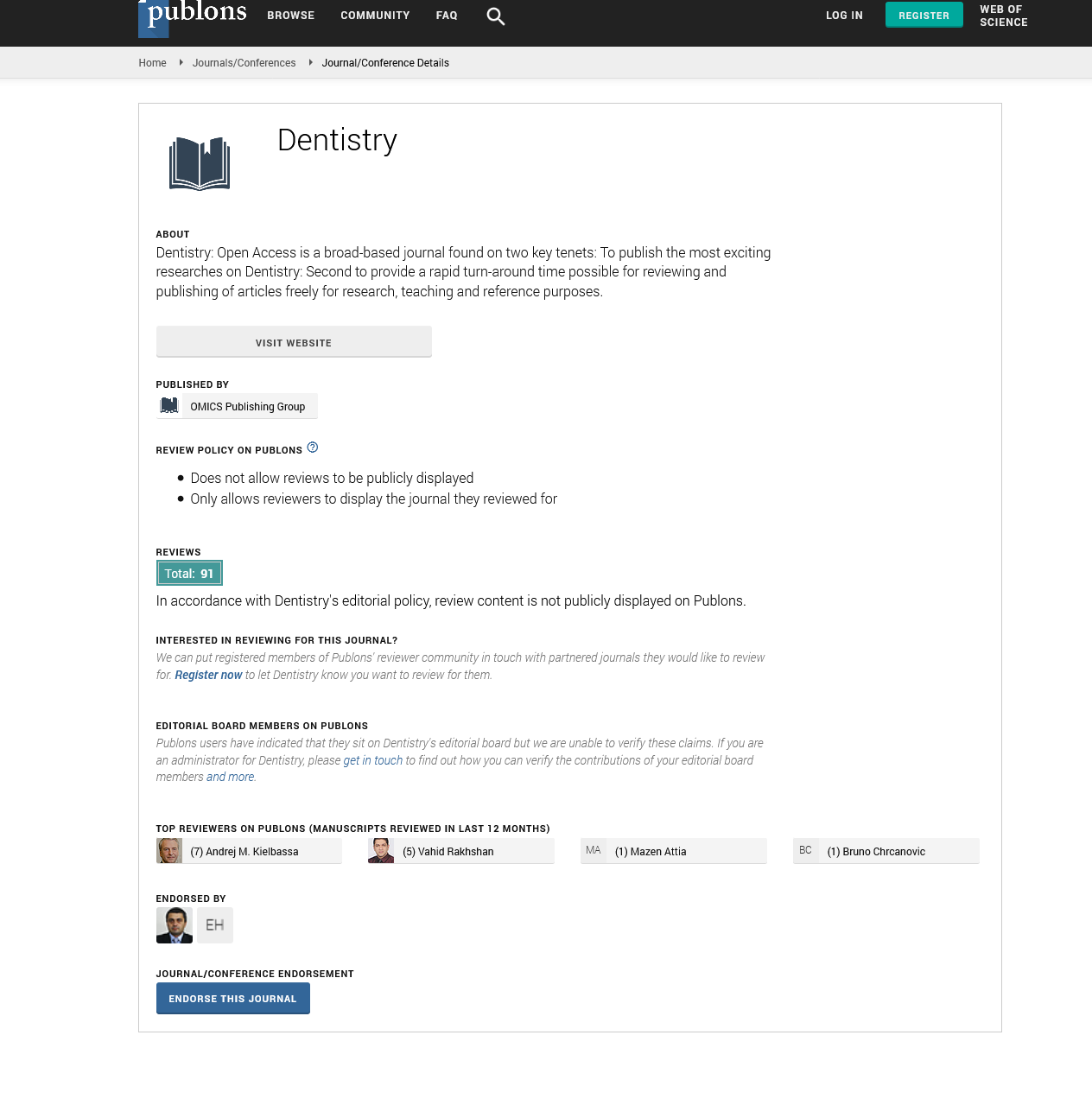Citations : 2345
Dentistry received 2345 citations as per Google Scholar report
Indexed In
- Genamics JournalSeek
- JournalTOCs
- CiteFactor
- Ulrich's Periodicals Directory
- RefSeek
- Hamdard University
- EBSCO A-Z
- Directory of Abstract Indexing for Journals
- OCLC- WorldCat
- Publons
- Geneva Foundation for Medical Education and Research
- Euro Pub
- Google Scholar
Useful Links
Share This Page
Journal Flyer

Open Access Journals
- Agri and Aquaculture
- Biochemistry
- Bioinformatics & Systems Biology
- Business & Management
- Chemistry
- Clinical Sciences
- Engineering
- Food & Nutrition
- General Science
- Genetics & Molecular Biology
- Immunology & Microbiology
- Medical Sciences
- Neuroscience & Psychology
- Nursing & Health Care
- Pharmaceutical Sciences
Perspective - (2023) Volume 13, Issue 4
Dental Biomaterials for Aesthetic Excellence
Toni Lee*Received: 30-Jun-2023, Manuscript No. DCR-23-22559; Editor assigned: 03-Jul-2023, Pre QC No. DCR-23-22559(PQ); Reviewed: 17-Jul-2023, QC No. DCR-23-22559; Revised: 24-Jul-2023, Manuscript No. DCR-23-22559(R); Published: 31-Jul-2023, DOI: 10.35248/2161-1122.23.13.652
Description
Dental biomaterials have revolutionized modern dentistry, offering innovative solutions to enhance oral health, restore damaged teeth, and improve patients' overall well-being. Dental biomaterials are specialized materials designed to interact with oral tissues, providing durable and biocompatible replacements for teeth and supporting structures. In recent years, significant progress has been made in the development of new dental biomaterials, leading to more effective and aesthetically pleasing dental restorations. This article explores some of the recent advances in dental biomaterials and their potential implications for the field of dentistry. Nanotechnology has had a profound impact on various industries, including dentistry. In dental biomaterials, nanotechnology allows for the manipulation of materials at the nanoscale, leading to improved properties such as increased strength, enhanced bond strength, and superior aesthetics.
Bioactive glasses have emerged as a class of dental biomaterials due to their unique ability to stimulate tissue regeneration. These glasses are composed of silica-based materials containing calcium and phosphate ions, which can integrate with the surrounding tissues, such as bone and dentin. In dentistry, bioactive glasses are used in various applications, including as dental filling materials and in the treatment of dentin hypersensitivity. The bioactivity of these glasses promotes remineralization and strengthens the tooth structure, contributing to improved longterm outcomes. The advent of 3D printing technology has revolutionized dental prosthetics and restorations. This innovative approach allows for the fabrication of custom-made dental devices, such as crowns, bridges, and dentures, with a high degree of accuracy and precision. 3D printing enables faster production times, reduces material waste, and ensures a better fit for patients. Additionally, this technology facilitates the creation of patient-specific models and surgical guides, streamlining complex dental procedures and enhancing treatment outcomes.
The development of smart dental materials has opened up new avenues for preventive and restorative dentistry. Smart materials can respond to environmental stimuli, such as changes in pH or temperature, to deliver specific therapeutic effects. For instance, smart dental composites can release fluoride ions in response to acid attacks, aiding in the prevention of secondary caries. These materials can also facilitate the controlled release of antimicrobial agents, promoting oral health by reducing bacterial growth and inflammation. Tissue engineering approaches using stem cells and scaffolds made from biocompatible materials have shown potential in restoring the structure and function of dental tissues. This field of research aims to develop therapies that can regenerate dental pulp, periodontal ligament, and alveolar bone, potentially eliminating the need for traditional dental implants and prosthetics.
The prevention of bacterial colonization on dental materials is significant to avoid infections and prolong the longevity of dental restorations. Recent advances in antibacterial materials have resulted in the development of dental composites and cements with inherent antimicrobial properties. These materials can help reduce the risk of secondary caries and other complications arising from bacterial biofilm formation.
Recent advances in dental biomaterials have brought about transformative changes in the field of dentistry. The integration of nanotechnology, bioactive glasses, 3D printing technology, smart materials, regenerative biomaterials, and antibacterial materials has significantly improved the quality and effectiveness of dental restorations and treatments. These advancements not only provide better functional outcomes but also enhance the aesthetics of dental restorations, leading to increased patient satisfaction. As research in dental biomaterials continues to evolve, it is expected that future innovations will further revolutionize dental care, making it more accessible, efficient, and patient-centered. Dental professionals and researchers must remain at the forefront of these developments to offer the best possible treatments and ensure the continued progress of modern dentistry.
Citation: Lee T (2023) Dental Biomaterials for Aesthetic Excellence. J Dentistry. 13:652.
Copyright: © 2023 Lee T. This is an open access article distributed under the terms of the Creative Commons Attribution License, which permits unrestricted use, distribution, and reproduction in any medium, provided the original author and source are credited.

